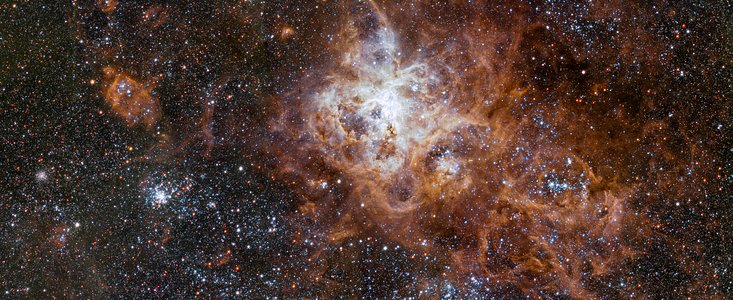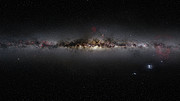Persbericht
Een drukke buurt
30 mei 2018
De helder gloeiende Tarantulanevel, ongeveer 160.000 lichtjaar van ons verwijderd, is de meest spectaculaire bezienswaardigheid van de Grote Magelhaense Wolk, een satellietstelsel van onze Melkweg. De VLT Survey Telescope van de ESO-sterrenwacht op Paranal in Chili heeft dit gebied en zijn rijke omgeving in prachtige details vastgelegd. De foto toont een kosmisch landschap van sterrenhopen, gloeiende gaswolken en de verspreide restanten van supernova-explosies. Dit is de scherpste opname ooit van dit complete gebied.
Door gebruik te maken van de capaciteiten van de VLT Survey Telescope (VST) van de ESO-sterrenwacht op Paranal in Chili, hebben astronomen dit zeer gedetailleerde nieuwe beeld van de Tarantulanevel en de talrijke naburige nevels en sterrenhopen vastgelegd. De Tarantulanevel, ook bekend als 30 Doradus, is het helderste en meest actieve stervormingsgebied in de Lokale Groep van sterrenstelsels.
De Tarantulanevel, bovenaan deze foto, strekt zich uit over meer dan 1000 lichtjaar en bevindt zich in het sterrenbeeld Dorado (Goudvis) aan de verre zuidelijke hemel. Deze prachtige nevel maakt deel uit van de Grote Magelhaense Wolk, een ongeveer 14.000 lichtjaar groot dwergsterrenstelsel. De Grote Magelhaense Wolk is een van dichtstbijzijnde buren van de Melkweg.
In het hart van de Tarantulanevel staat een jonge, reusachtige sterrenhoop die NGC 2070 wordt genoemd. Dit is een actief stervormingsgebied waarvan de dichte kern, R136, enkele van de zwaarste en helderste sterren bevat die we kennen. De heldere gloed van de Tarantulanevel zelf werd in 1751 voor het eerst vastgelegd door de Franse astronoom Nicolas-Louis de Lacaille.
Een andere sterrenhoop in de Tarantulanevel is de veel oudere Hodge 301, waarin naar schatting minstens veertig sterren als supernova zijn geëxplodeerd, waarbij gas over de omgeving is verspreid. Een voorbeeld van zo’n supernovarest is de superbel SNR N157B, die de open sterrenhoop NGC 2060 omsluit. Deze sterrenhoop werd in 1836 voor het eerst waargenomen door de Britse astronoom John Herschel, die gebruik maakte van een 47-cm spiegeltelescoop in Kaap de Goede Hoop in Zuid-Afrika. Aan de rand van de Tarantulanevel, aan de rechter onderkant, ligt de plek waar in 1987 de beroemde supernova SN 1987A [1] verscheen.
Aan de linkerkant van de Tarantulanevel komen we de heldere open sterrenhoop NGC 2100 tegen. Deze bestaat uit een schitterende concentratie van blauwe sterren, omringd door rode sterren. Deze cluster werd in 1826 met een zelfgebouwde 23-cm spiegeltelescoop ontdekt door de Schotse astronoom James Dunlop, die toen in Australië werkte.
In het midden van de foto staat de sterrenhoop en emissienevel NGC 2074, een ander kolossaal stervormingsgebied dat door John Herschel is ontdekt. Als je goed kijkt, zie je een donkere zeepaardvormige stofstructuur – het ‘Zeepaard van de Grote Magelhaense Wolk’. Dit is een reusachtig complex van stofzuilen met een lengte van ongeveer 20 lichtjaar – bijna vier keer de afstand tussen de zon en de dichtstbijzijnde ster, Alfa Centauri. Deze structuur is gedoemd om in de loop van de komende miljoenen jaren te verdwijnen: naarmate zich meer sterren in de sterrenhoop vormen, worden de stofzuilen geleidelijk weggeblazen door het licht en de winden die deze sterren produceren.
De totstandkoming van deze foto is te danken aan OmegaCAM, de speciaal ontworpen 256-megapixel camera van de VST. De foto is opgebouwd uit OmegaCAM-opnamen die door vier verschillende kleurenfilters zijn gemaakt. Een van deze filters laat specifiek de rode gloed van geïoniseerde waterstof door [2].
Noten
[2] De H-alfa-emissielijn is een rode spectraallijn die ontstaat wanneer het elektron in een waterstofatoom energie verliest. Dit gebeurt in het waterstof rond hete jonge sterren wanneer het gas geïoniseerd raakt door de intense ultraviolette straling, en elektronen zich vervolgens recombineren met protonen om weer atomen te vormen. Het vermogen van OmegaCAM om deze lijn te detecteren, stelt astronomen in staat om de fysica van reusachtige, sterren-vormende moleculaire wolken te onderzoeken.
Meer informatie
ESO is de belangrijkste intergouvernementele astronomische organisatie in Europa en verreweg de meest productieve sterrenwacht ter wereld. Zij wordt ondersteund door vijftien lidstaten: België, Denemarken, Duitsland, Finland, Frankrijk, Italië, Nederland, Oostenrijk, Polen, Portugal, Spanje, Tsjechië, het Verenigd Koninkrijk, Zweden en Zwitserland, en door gastland Chili, met Australië als strategische partner. ESO voert een ambitieus programma uit, gericht op het ontwerpen, bouwen en beheren van grote sterrenwachten die astronomen in staat stellen om belangrijke wetenschappelijke ontdekkingen te doen. Ook speelt ESO een leidende rol bij het bevorderen en organiseren van samenwerking op astronomisch gebied. ESO beheert drie waarnemingslocaties van wereldklasse in Chili: La Silla, Paranal en Chajnantor. Op Paranal staan ESO’s Very Large Telescope (VLT) en haar toonaangevende Very Large Telescope Interferometer, evenals twee surveytelescopen – VISTA, die in het infrarood werkt, en de op zichtbare golflengten opererende VLT Survey Telescope. ESO speelt tevens een belangrijke partnerrol bij twee faciliteiten op Chajnantor, APEX en ALMA, het grootste astronomische project van dit moment. En op Cerro Armazones, nabij Paranal, bouwt ESO de 39-meter Extremely Large Telescope, de ELT, die ‘het grootste oog op de hemel’ ter wereld zal worden.
Links
Contact
Richard Hook
ESO Public Information Officer
Garching bei München, Germany
Tel: +49 89 3200 6655
Mob: +49 151 1537 3591
E-mail: rhook@eso.org
Rodrigo Alvarez (press contact België)
ESO Science Outreach Network
en Planetarium, Royal Observatory of Belgium
Tel: +32-2-474 70 50
E-mail: eson-belgië@eso.org
Over dit bericht
| Persberichten nr.: | eso1816nl-be |
| Naam: | Tarantula Nebula |
| Type: | Local Universe : Star : Grouping : Cluster Local Universe : Nebula |
| Facility: | VLT Survey Telescope |
| Instruments: | OmegaCAM |
Our use of Cookies
We use cookies that are essential for accessing our websites and using our services. We also use cookies to analyse, measure and improve our websites’ performance, to enable content sharing via social media and to display media content hosted on third-party platforms.
ESO Cookies Policy
The European Organisation for Astronomical Research in the Southern Hemisphere (ESO) is the pre-eminent intergovernmental science and technology organisation in astronomy. It carries out an ambitious programme focused on the design, construction and operation of powerful ground-based observing facilities for astronomy.
This Cookies Policy is intended to provide clarity by outlining the cookies used on the ESO public websites, their functions, the options you have for controlling them, and the ways you can contact us for additional details.
What are cookies?
Cookies are small pieces of data stored on your device by websites you visit. They serve various purposes, such as remembering login credentials and preferences and enhance your browsing experience.
Categories of cookies we use
Essential cookies (always active): These cookies are strictly necessary for the proper functioning of our website. Without these cookies, the website cannot operate correctly, and certain services, such as logging in or accessing secure areas, may not be available; because they are essential for the website’s operation, they cannot be disabled.
Functional Cookies: These cookies enhance your browsing experience by enabling additional features and personalization, such as remembering your preferences and settings. While not strictly necessary for the website to function, they improve usability and convenience; these cookies are only placed if you provide your consent.
Analytics cookies: These cookies collect information about how visitors interact with our website, such as which pages are visited most often and how users navigate the site. This data helps us improve website performance, optimize content, and enhance the user experience; these cookies are only placed if you provide your consent. We use the following analytics cookies.
Matomo Cookies:
This website uses Matomo (formerly Piwik), an open source software which enables the statistical analysis of website visits. Matomo uses cookies (text files) which are saved on your computer and which allow us to analyze how you use our website. The website user information generated by the cookies will only be saved on the servers of our IT Department. We use this information to analyze www.eso.org visits and to prepare reports on website activities. These data will not be disclosed to third parties.
On behalf of ESO, Matomo will use this information for the purpose of evaluating your use of the website, compiling reports on website activity and providing other services relating to website activity and internet usage.
Matomo cookies settings:
Additional Third-party cookies on ESO websites: some of our pages display content from external providers, e.g. YouTube.
Such third-party services are outside of ESO control and may, at any time, change their terms of service, use of cookies, etc.
YouTube: Some videos on the ESO website are embedded from ESO’s official YouTube channel. We have enabled YouTube’s privacy-enhanced mode, meaning that no cookies are set unless the user actively clicks on the video to play it. Additionally, in this mode, YouTube does not store any personally identifiable cookie data for embedded video playbacks. For more details, please refer to YouTube’s embedding videos information page.
Cookies can also be classified based on the following elements.
Regarding the domain, there are:
- First-party cookies, set by the website you are currently visiting. They are stored by the same domain that you are browsing and are used to enhance your experience on that site;
- Third-party cookies, set by a domain other than the one you are currently visiting.
As for their duration, cookies can be:
- Browser-session cookies, which are deleted when the user closes the browser;
- Stored cookies, which stay on the user's device for a predetermined period of time.
How to manage cookies
Cookie settings: You can modify your cookie choices for the ESO webpages at any time by clicking on the link Cookie settings at the bottom of any page.
In your browser: If you wish to delete cookies or instruct your browser to delete or block cookies by default, please visit the help pages of your browser:
Please be aware that if you delete or decline cookies, certain functionalities of our website may be not be available and your browsing experience may be affected.
You can set most browsers to prevent any cookies being placed on your device, but you may then have to manually adjust some preferences every time you visit a site/page. And some services and functionalities may not work properly at all (e.g. profile logging-in, shop check out).
Updates to the ESO Cookies Policy
The ESO Cookies Policy may be subject to future updates, which will be made available on this page.
Additional information
For any queries related to cookies, please contact: pdprATesoDOTorg.
As ESO public webpages are managed by our Department of Communication, your questions will be dealt with the support of the said Department.






